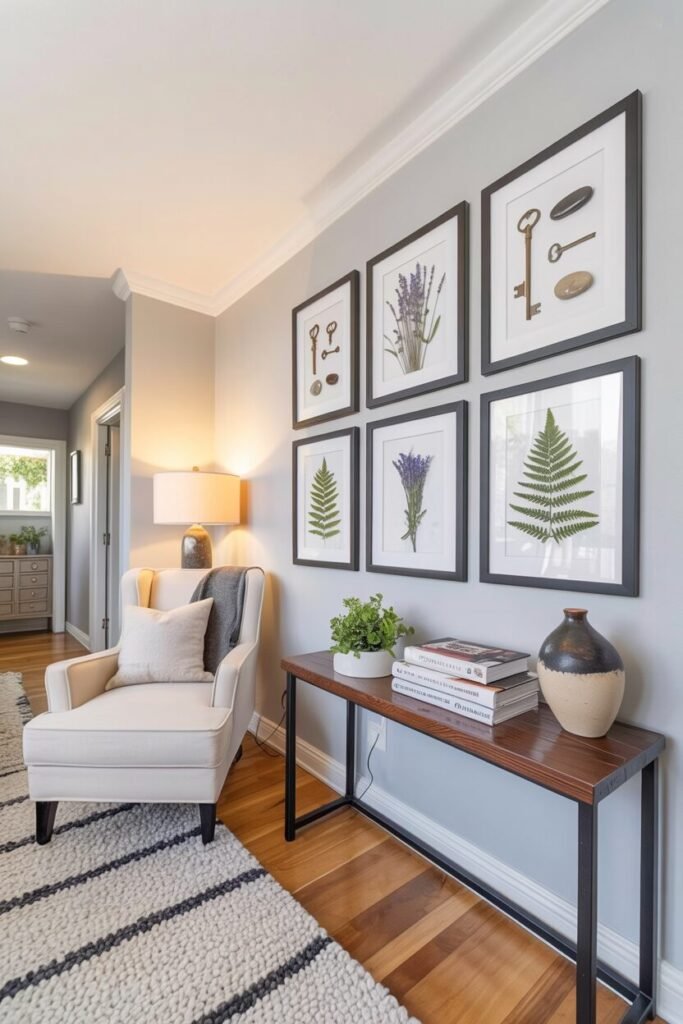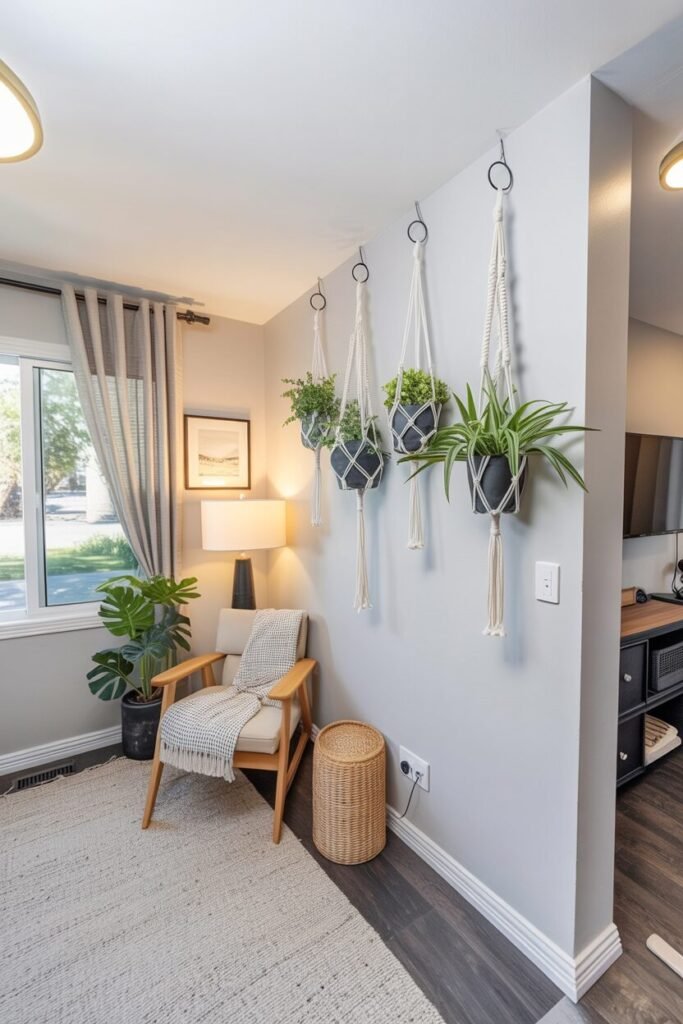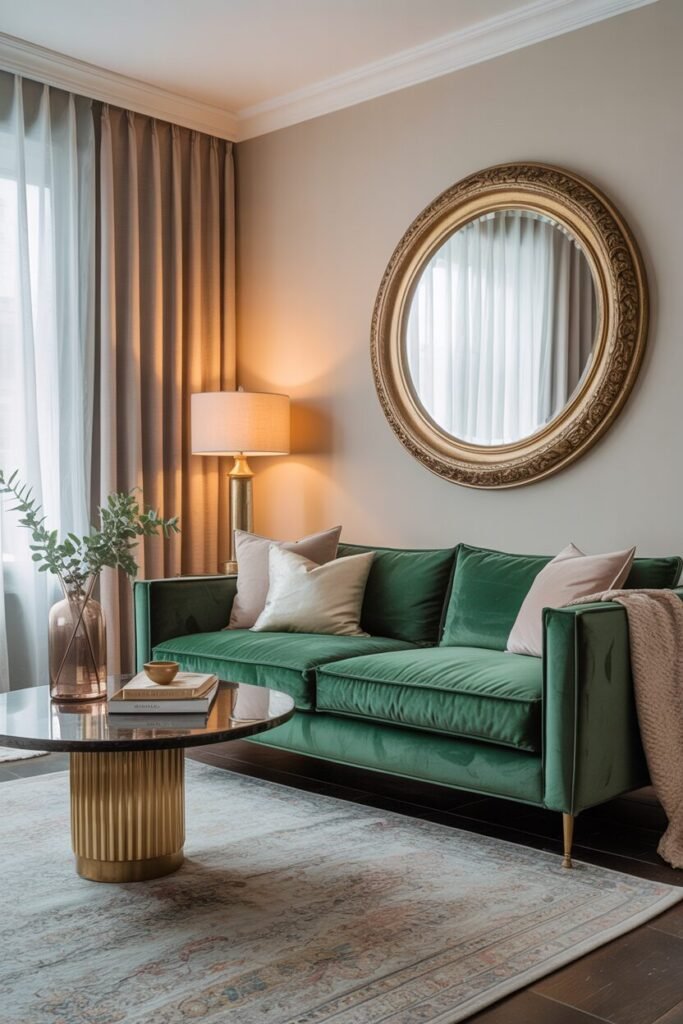From Blank to Brilliant: Wall Décor Ideas That Elevate Your Living Space

Come on, we all love a fresh canvas – but your living room isn’t the waiting room at the dentist, guys. Unless your walls remain au naturel-ing, you’re missing the chance to provide your room with the gravitas it so desperately needs. Wall decor is less about flaunting your horrible art sense but as storytelling in the room.
Do it correctly, and it provides a little eye candy to the space, guides your eye somewhere, and keeps your furniture from having their own Macarena dance party. Do it horridly… you’ve got sofas suspended in mid-air à la floating clouds and a “We just moved in!” vibe (despite the three lovely years).
This wee guide is here to deconstruct wall decor concepts which actually employ design concepts – no impulse “hang something nice and hope it works” malarkey here. And, yes, we are indeed going to use terms such as scale, proportion, rhythm, and focal points. Sounds like rocket science? It is. But also totally doable – unless, of course, you’re emotionally bonded to your builder beige.
Macramé Wall Hangings: How Boho Never Gets Out of Fashion (Apparently)
Macramé is the interior decorating world’s equivalent of folk music –gritty-textured, snuggly, and a teensy bit too seventies. Not only is this pretty little knotted thingy gorgeous, but it’s going to wrap all those hard, cold surfaces in your living room in a big great hug.
That’s a fancy design principle called material interplay – you’re basically softening the room with fiber and texture, which helps balance out all that sleek metal, glass, or (gasp!) pleather. Bonus points: macramé actually eats sound. So, yeah, it totally tames the room. Want to make it look classy and not nearly so much your college dorm room’s questionable DIY effort? Get the colors more neutral, remove the big chunks, and ensure that they’re living solid framing or dowels.
A macramé wall hanging on the fireplace or above the couch could be just that wonderful conversation starter that proudly proclaims, “We didn’t lose our minds buying this on Etsy at 2 AM!” Because, honestly, we’ve all been there.
Framed Textiles and Fabrics (Yes, That Ripped-Up Old Scarf Is Art – We Swear!)
Textiles as a work of wall art Oh, yes. And no, we don’t mean thumbtacking some dodgy tapestry like a freshman college student who just discovered incense. Framed textiles are sophisticated visual nuances that add pattern and texture to your environment. Think frayed scarves your grandmother probably wore, very detailed panels of elaborate embroidery, or maybe fragments of hand-woven trash.
The secret is in the matting – plain mats, plenty of white (or a little bit of high-brow matting), and intelligent positioning. Staling is a technique sheer wizardry, particularly if your decor is more understated, because the fabric brings warmth but no visual mass from some crass, in-your-face piece of art.
Design-wise, it introduces soft contrast and a dash of global or vintage swagger – without making it look like you’re trying way too hard. Bonus: zero chance of accidentally twinning with your friend’s mass-produced IKEA print.
The Classic Gallery Wall (a.k.a. The Pinterest Favorite)
The gallery wall isn’t just about haphazardly slapping random frames on drywall until it “feels right.” Oh no, when done correctly, it’s deeply rooted in the design principle of rhythm and balance. You’re basically orchestrating a carefully controlled visual symphony – mixing sizes, shapes, and visual weights to lead the eye on a merry dance.
It’s wall jazz: anarchy made pretty. Same spacing (two or three inches, people, not anarchy), throw in the midline, then out to the rest from there. The odd-numbering placement so it doesn’t look like the police station lineup, and for goodness’ sake, don’t line everything up – symmetry is good, but asymmetry has so much more pizzazz.
Need to add some gravitas to it? Do something with it – paint, drawings, perhaps even that awful little bit of 3D art that is making people utter cringeworthy things. Tip: place it on the floor in advance. If messy on the floor, it won’t magically be okay up on the wall. Undess your walls are enchantingly magical#undefined(Spoiler alert: they’re not.)
Macramé Plant Hangers (Technically Wall Decor and Totally Adorable, Don’t Judge Us)
Alright, let’s bend the rules of “wall decor” just a smidge – because hanging planters are having their moment in the sun, and macramé versions bring in double the design points. First, you’re finally using that neglected vertical space. Second, you’re injecting some biophilic design elements – fancy talk for “plants make humans less miserable.”
Third, you’re getting extra texture from those cords, which creates a lovely visual rhythm against flat walls. Hang one or two in a lonely corner or near a window, and suddenly, that awkward void has transformed into a cozy nook. Just for beauty’s sake alone, don’t suspend seventeen of them unless your final design is “urban jungle that totally lost its mind.”
Macramé Meets Mirror: Functional AND Fabulous
That’s where function and beauty meet and flirt with each other kinda sassy-like. A macramé-framed mirror is essentially a multitasking superhero: it’s a light reflector (so your room will be like it took a spatial illusion pill) and a do-it-yourself cuteness aroma.
Place it in front of a window with intent, and it’ll bounce daylight further into the room like a good little puppy. Design is where it’s at – choose a macramé that’s not attempting to wrap the whole mirror, and spare the mirror, ahem, its status as a mirror. Centre-console or fireplace place it to achieve a vignette layered look. Place a teensy vase and candle on top, and voilà: you’ve achieved bohemian symmetry for a purpose. Thanks.
READ MORE >> “How to Pick a Luxury Living Room Color Palette—Using Designer-Approved Tricks“
Oversized Art Pieces: Go Big or Go Home
It’s intimidating, yes. But nothing screams “intentional design” more loudly than one enormous, huge piece of art that simply aches to have a wall – and aches to have it in style. Big because it provides a clear visual anchor, stabilizing the space with one huge statement.
The trick, dears, is proportion. Your piece should be two-thirds the size of the furniture it’s draped over (usually your sofa or sideboard). Be bigger still if walls are canyon deep or ceilings vaulted. Abstracts, line drawing minimalism, or a decent photograph will sit alone most certainly – if the frame is understated so the art can breathe. This is not bragging on how good your taste is in expensive things; it’s making the space appear as though it’s balanced and harmonious.
It’s where we can leave our signature on the space without having to tell anyone. Although, between you and me, we have no idea what we’re doing.
Floating Shelves That Secretly Show Off Your Personality
Let’s provide them with what they’re worthy of: introvert gallery walls. Floating shelves are your go-to to stock with books, bizarre artwork, little knick-knacks of dubious taste, and, yes, even plants – all in a modular, mod-as-we-go setup. They’re ideal for us commitment-phobes who desire wall decor but can’t figure out how to wield a hammer.
Actual design brawn here is visual hierarchy: piles of units at both ends, middles in tiers, and lots of different heights to keep the eye traveling. Utilize repeat color across to connect the dots – it’s a visual drum section. For goodness’ sake, please, please don’t leave no single square inch vacant. Not every single square inch must have a itsy-bitsy ceramic bird. Sometimes, restraint is the real power move.
The Return of Wood Paneling—But Make It Fashion
Relax, we’re not dragging your grandpa’s 1970s basement back from the dead. Today’s wood paneling is sleek, vertical, and often rocking chic colors like sage green, matte black, or dusty navy. This wall treatment creates architectural detail and provides your wall with a function beyond “supporting the ceiling.”
Thin slats or tongue-and-gaps for that streamlined, modern aesthetic, and then perhaps halfway up as well for that retro, wainscoting-but-make-it-Scandi look. For the sake of aesthetics alone, paneling is absolutely fabulous with shadow and dimension – particularly when paired with some va-va-va-voom light. It’s also a rescuer of the cringe-worthy “We don’t know what to hang on this” walls. Sometimes the wall is the art. Rad, we’re informed.
Sconces and Wall Lamps That Double as Sculptures
Lighting posing as art in the guise of a wall decoration? Of course. Especially when said fixture looks like it swooned over from a modern art museum. Sconces and in-wall lamps are more-than-stupid-beautiful ways of accomplishing function and design and providing ambience and also sculptural prettiness. The key design principle here is layered lighting – you’re not just blasting the room with overhead light; you’re adding pools of warmth and texture.
Install a pair of asymmetrical sconces flanking a piece of art or a bookshelf, and suddenly the whole wall feels like it got a promotion. Specialty shape grip fixtures – natural brass shapes, matte black arms, or stylish glass orbs – to bring some serious depth to the room. And believe us, nobody ever complains, “There’s too much flattering lighting in here.” Zoom calls will thank you.
READ MORE >> “10+ Stunning Living Room Fireplace Ideas You Want to Copy“
Minimalist Grid Layouts for the Type-A Decorator
If gallery walls do make your neatly-aligned spine tremble, however, the grid system is your calm, faultlessly-aligned savior. It’s a hard-symmetry system and agonizingly-spaced – think tidy columns and rows of identical frame, diligently levelled (or good enough to fool easily gullible eyes).
It’s the design equivalent of a ghastly big, comforting gasp. Grid composition is best suited to pre-conceived art – black-and-white photography, botanical watercolors, monochromatic abstractions.
Such wonderful thing about it is the visual cohesion that it creates in a room. It brings rhythm and calmness, especially in those rooms that already have a lot of visual activity. Tip: Employ the same color frame and same type of matting so the look is tidy, not hectic. Because frenzy isn’t what your walls were chopped out to handle, not your email.
Before You Pick Up That Sledgehammer (For Our Sake, Do This First)
Reality check: Your walls in the living room aren’t there to keep the roof from falling and to be a dust bunny factory for the corner. They’re one of the largest, most under-leveraged design assets available to you – and you don’t have to be an interior architect to make ’em pay off.”
If you’re a maximalist freak with a crazy gallery wall or Zen with a thoughtfully laid out grid of single-color photos, the result is the same: to generate interest, equanimity, and make the room feel like it’s yours – and not some tomb-like furniture brochure. So, take a giant step back, squint at your walls like a suspicious art critic, and ask yourself: Is this space saying anything… or just mumbling beige?
And if all else fails, just add a plant. Or five. That usually does the trick. You’re welcome.













